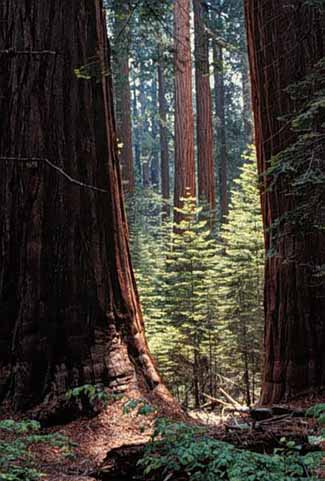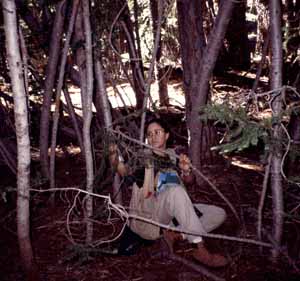Sierra Nature Notes, Volume 5, May 2005
“Live
fast, die young” also
applies to forests
Nathan
L. Stephenson * and Phillip J. van Mantgem †
*
Corresponding author: nstephenson@usgs.gov
† pvanmantgem@usgs.gov
USGS
Western Ecological Research Center, Sequoia and Kings Canyon Field Station,
HCR 89 Box 4, Three Rivers, CA 93271
 |
| Giant
Sequoias and understory of White Fir, Sequoia National Park. The ancient Sequoia overstory may not be affected as quickly by climate change. NPS Photo |
Forests provide humans with economically important and often irreplaceable products and services, and affect global climate by acting as sources and sinks of heat-trapping carbon dioxide. Yet the possible responses of forests to ongoing environmental changes are poorly understood. In a recent article we published in Ecology Letters (31 January 2005), we show that birth and death rates of trees vary in parallel with global and regional patterns of forest productivity.
In less productive forests, such as coniferous forests growing at high latitudes, a century or more can pass before half of all trees die and are replaced with new growth. In contrast, in the world’s most productive forests – tropical forests growing on fertile soils – half of all trees die and are replaced by new growth in only thirty years. Similar patterns appear at much smaller spatial scales. Over a 1900-meter (6,200 feet) elevational gradient in the Sierra Nevada of California, turnover rates of coniferous forests vary by almost a factor of four.
One implication of this fast turnover rate is that the world’s most productive forests may be those likely to respond most quickly – positively or negatively - to such things as climatic change. If you view a forest like a bank account, as long as deposits and withdrawals are similar, your balance remains stable. But if the deposits or withdrawals are disrupted, the balance changes.
In productive forests, such as tropical forests growing on rich soils, the rates of both “deposits” (tree births) and “withdrawals” (tree deaths) are high. But if tree births suddenly stopped, or if tree death rates doubled, the numbers of trees in these forests would be halved in just 30 years.
In contrast, in less productive forests, such as coniferous forests growing at high latitudes, the same changes could take more than a century to occur. Thus, managers wishing to establish forest monitoring programs for change detection may wish to devote extra effort toward monitoring their most productive forest types.
We offer three non-mutually exclusive mechanisms that might explain the correlation between net primary productivity (NPP) and forest turnover rate. The first might be considered the bottom-up mechanism. On intrinsically productive sites, faster tree growth might simultaneously lead to increased fecundity, more intense competition, and quicker outcomes of competition (i.e., tree death), translating to higher turnover rates.
Second (the top-down mechanism), sites with high potential for primary production will usually also have high potential for secondary production. For example, the warm, moist, aseasonal environments that best favor rapid plant growth also best favor the organisms that attack plants (such as insects, fungi, and nematodes), potentially leading to higher death rates. (Indeed, rates of herbivory appear to be higher in tropical than in temperate forests, in spite of greater plant defenses in the tropics. These higher death rates translate to frequent creation of forest openings and local reductions in competition, leading to higher recruitment rates.
 |
| Dense young stand of White Fir. Changing forest density and mortality affects wildlife populations as well as carbon dioxide storage, which could influence climate change. |
Third (the tradeoffs mechanism), trees may face significant tradeoffs between allocating resources toward growth or toward persistence. Specifically, rapid growth may come at the expense of reduced defenses or structural integrity, and the abiotic environment may directly or indirectly select for a particular balance between the two. For example, nutrient-poor soils might select for species that allocate significant resources toward anti-herbivore defenses, simultaneously reducing both growth rates and mortality rates (Fine et al. 2004).
Especially in the case of top-down control of turnover rates, increased NPP might be a consequence, not a cause, of increased mortality rates. That is, herbivores and pathogens would cause tree mortality to be higher, which in turn would result in proportionally more forest area being maintained in younger forest patches. Because NPP is generally highest in young forest patches, the forest as a whole would express higher NPP.
Much emphasis has been placed on the possibility that forest die-offs will be triggered by environmental changes that reduce forest vigor – such as climatic drying. Our study suggests that forests may also be affected by environmental changes that are generally thought to increase forest vigor and productivity – such as nitrogen deposition and increasing precipitation. Specifically, environmental changes that lead to increased forest productivity may also lead to increased forest turnover rates (birth and death rates), which in turn may have cascading effects on other properties of forest ecosystems. For example, increased forest turnover might lead to forests that are more heavily dominated by younger and smaller trees, which in turn could affect wildlife populations and biodiversity.
Additionally, increased dominance by younger and smaller trees can lead to changes in forest carbon storage. Carbon dioxide, a heat-trapping gas implicated in climatic warming, increases as carbon storage in forests decreases, and decreases as carbon storage in forests increases. Given the central importance of forests to the global carbon cycle (hence global climatic change), and the increasing importance of carbon storage to international treaties and trading of carbon credits, it is important to develop a solid understanding of the relationships among forest productivity, turnover, and carbon storage.
Management Implications:
• More productive forest types may be quicker to respond to environmental changes than less productive forest types. This may be particularly relevant to the design of monitoring programs for change detection.
• Environmental changes that increase forest productivity (e.g., nitrogen deposition or certain climatic changes) may also increase forest turnover rates, with the potential for cascading effects on wildlife, biodiversity, and forest carbon storage.
Further Reading
Stephenson, N. L., and P. J. van Mantgem. 2005. Forest turnover rates follow global and regional patterns of productivity. Ecology Letters 8.
FORESTRY ISSUES: Tropical Forests and Climate Change
Climate Change Impacts on the United States
Our Founder Questions? Go to About Our New Site |
Masthead
Photo from: |